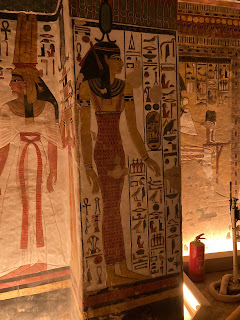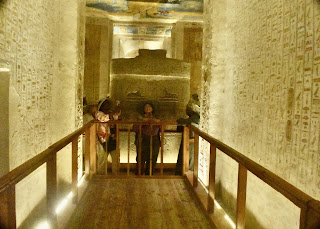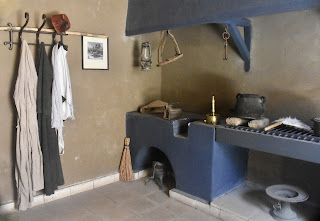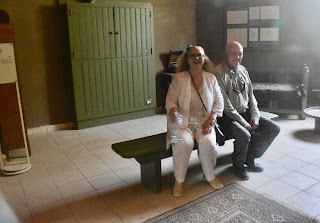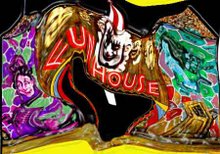To be honest I was getting pretty tired by this time, but I was really looking forward to the next tomb. I must have slept some, because I don't remember much about the bus ride to the Valley of the Queens, but I have a few photos of things we passed by.
There is so much going on all over this area, that it would take a genius busybody to be up on everything that is being excavated.
This could be homes of worker artisans which are around this area somewhere, or it could be something completely different. The curvy wall suggests something more recent to me, but who knows!
When they let us out of the bus we walked into the Valley of the Queens.
Once again there was evidence of dozens of other tombs. Every grated entry marked a story (mostly unknown (to me at least)) of a mysterious Noble living thousands of years before.
Eventually we reached a marker. It was pretty unimpressive for marking what some have called the Sistine Chapel of Ancient Egyptian tombs.
Once again the surroundings were inhospitable, hot and barren, but there was a small shed with fans, a water cooler and some information signs set up to shield those waiting from the sun.
Queen Nefertari was the favorite wife of Ramses the Great. She was clearly very important for we have seen her depiction already many times at Karnak and Luxor (and would again of course at Abu Simbel).
Ramses II (the Great) had at least eight wives, two of which were his own daughters and one his sister. He also married two Hittite princesses. Speculation is that Ramses married Nefertari when she was a teenager in order to improve political relations with her homeland of Thebes.
Above you see the ever-present security. I calculate that about 2% of male Egyptians work for the military. Note the scary-looking weapon lying casually on the bench.
This is what the waiting area looked like.
Visitors are allowed in the tomb for only 10 minutes at a time, because the moisture from breath can be damaging to the paintings and unlike most of the other tombs in the area, the paintings are not covered by glass panels. The limestone in the Valley of the Queens has a particularly high salt content and is more fragile than in some other areas. I fear that some day they will decide that they need to close this tomb to the public entirely, so I feel fortunate to have had the chance to see it, but of course ten minutes is not enough time to do much more than take in the beauty of the setting. Here is the wikipedia layout map of the tomb. Only ten minutes to see the whole thing! Wow!

The entrance stairs (1) are undecorated. So the first view of art comes in room 1 (Chamber C in the official Archaeological designation). C is a roughly 5 meter by 5 meter space with a mural of Queen Nefertari in three forms. (Below) she is shown playing the board game Senet (possibly a predecessor of chess) on the south wall next to the entry stairs. Her Ba (or (mobile) soul) is shown in the middle of the panel and then the queen is depicted again in supplication on the right.
Here is a close up of the Senet game. (Image from the
Getty collection.) You can also see the cartouche with her name in the white oval.
The west wall of the chamber C (connected on the right to the image above) shows the benu bird (an egret-like bird variously identified as a heron or stork, but definitely looks like an egret to me!) to the left of the mummified body of Nefertari (who wears a funerary mask and is seen lying on a bier). On either side are the goddesses Nephthys (a sister of Isis with whom she is usually paired in funerary paintings) and Isis (with the throne on her head) both depicted in their "kite" form. The green god on the right is a water god with a hand on a symbol of protection
Below is a view looking toward chamber G. (Note the beetle headed god Kheperi on the left.)
Because he represents the rising sun, he is connected with renewal of life. Speculation is that because dung beetles appeared out of dung, hence nothing, they represented life coming out of nowhere. (Probably they were not aware of the eggs inside the dung). The beetles were also seen rolling around the perfectly round little balls of dung, which were associated with the orb of the sun. (Photo by Charles J. Sharp from Wikipedia).
Thus the beetles were associated with the sun coming out of nowhere in the morning, or the rising of the sun. Here is a better view of Kheperi.
Standing in the first chamber and looking east you can see the entrance to rooms 2 and 3. On the far right is Osiris god of the dead (south wall) accompanied by Anubis (east wall) (Osiris has a companion piece on the other side of the opening to recesses and Chamber G in the back). Note the vulture over the far back lintel to Chamber G depicting the vulture god Nekhbet who holds protection charms in each claw.
Here is a detail of the closer lintel showing rows of ureai (upright cobras symbolizing sovereignty) and feathers representative of the goddess Ma'at (goddess of harmony, truth and justice). An unidentified god (perhaps a version of Horus?) in the center has his hands on ovals containing stylized oudjat (eye of Horus) eyes which are an apotropaic charm of protection. The sky on the ceiling gets its distinctive color by painting blue over an underlayer of black paint.
This is a closer look at the recess which forms an entrance to side chamber G (cut off at the left). Archaeologists label it Recess E (3 on the map above.) We see the goddess Hathor holding a supporting hand behind the falcon-headed god Re'-Horakhty, who is holding the ankh (the sign of life force).
The goddess Neith is seen on the north recess wall (F) between numbers 3 and 4 on the map above. Neith was a huntress/war goddess, who is also associated with weaving. That may be a weaving shuttle that she wears on her headdress.
She is doubled by the goddess Ma'at on the mirror recess wall to the south. This shot is taken from within Chamber G (4) facing west. In the image above as well as in the mural below Nefertari is presented in her double-plumed crown (which was favored by her ancestor/namesake Nefertari-Ahmose). She is portrayed below as offering linen to the creator god Ptah (depicted in mummy form). The offering is a gift in exchange for the granting of enough linen for the wrapping of her mummy.

On the opposite wall of Chamber G (to the East) is one of my favorite paintings. It depicts seven cows and a bull facing Nefertari, who stands around the corner on the south wall. The painting is a representation of book 148 of the Book of the Dead. (𓂋𓏤𓈒𓈒𓈒𓏌𓏤𓉐𓂋𓏏𓂻𓅓𓉔𓂋𓅱𓇳𓏤, r(ꜣ)w n(y)w prt m hrw(w)). This text starts to show up in the New Kingdom (circa 1550 BCE). It seems to be a collection of writings to give the spirit of the dead spells and directions for navigating the Duat, or underworld that must be traversed after death. In the image, there are bovines placed beneath an elongated hieroglyph for the sky. They are flanked by was scepters. In front of each is a small altar with vegetable, milk and bread offerings. These seven cows have the power to provide the Queen's spirit with its post mortem needs. The oars below are also referenced in the same passage of the Book of the Dead and relate to being able to maneuver among the stars.

The south wall of that room shows the goddesses Nephthys and Isis flanking the ram-headed god, here identified as Re'.
If you look at the text at the goddesses knees you might be able to see that the text does an interesting crossover of emblems.
The writing on the left by Nephthys' legs starts with eye, god, throne
𓁹𓀭𓊨
and ends with mouth, arm, god, sun, vertical line.
𓂋𓂝𓀭 ![N5 [ra] ra](https://en.wikipedia.org/w/extensions/wikihiero/img/hiero_N5.png?08eb7)
 |
|
The writing on the right reverses the order: mouth, arm, god, sun, vertical line and ends with eye, god, throne. What the text is telling us more or less, that (left): It is Osiris (the god of the underworld) who sets as Re' (the sun god) and (right) it is Re' who sets as Osiris. Thus, the sun that sets in the evening travels through the underworld as Osiris and then Osiris sets as the sun enters the living world.
The north wall shows Nefertari paying homage to Thoth. I have no idea what that frog means specifically here, but frogs were associated with fertility and rebirth. Why it appears along with the god of wisdom and writing, I don't know, but Thoth is often paired with Ma'at in paintings, each standing on across from each other on the barque of the sun.
Heading farther North and down the stairs leading from Chamber C deeper into the tomb, are the stairs (5) leading down to the sarcophagus chamber K (Room 8). This shot faces to the South.
This is the east side of the descending corridor (on the left above). The back wall has Neith on one side and Serket, the scorpion goddess on the other. The image of Serket, (above left) we have seen before in the tomb of Tutankhamun. She was the goddess of curing snake and venom bites.
The two sides of the descending stair mirror each other in triangular panels. In the small part of the panel, we see (the wings of) Ma'at, Isis and Nephthys. Just barely visible here are the offerings they are receiving from Nefertari (off camera left) on the descending corridor on the west side.
Below is the version on the east side. Here Nefertari stands in front of a pile of offerings of bread and vegetables which are being presented to the goddess Hathor (Serket and Ma'at being cut off left). There are two smoking braziers on top of the offering pile. The Queen presents two nemset (ritual vessel) jars to the goddesses along with the offerings. This version differs from the west side version in a couple of ways. There are meats in the offering pile on the west side and the Queen has plumes on her crown. In the east side version the artist has decided to add more honorific titles above the queen and so she wears a flat crown without feathers.
Here is Nefertari's cartouche on one of the door jambs of the stairway down to the lower level.
Anubis (son of the goddess Nephthys and associated with the weighing of the heart after death) is painted on both sides of the mural depicted above farther toward the north end of the stairway (cut off on the edges of the above image).
The stairway descends to room K (Room 6 or #8 on the map above), which has four square pillars, with gods painted on each of the four sides. The chamber measures 10.4 by 8.2 meters and thus feels more spacious than the areas we have previously been in. A low bench runs around the perimeter of the room and may have been a place for setting funerary objects and a depression in the center is where the sarcophagus must have originally been located. The west side of the room depicts scenes from Chapter 144 (the gates) from the
Book of the Dead and the right side concentrates on Chapter 146 (the portals of this world).
This shot looks north in the direction of chamber (room 7 #10) looking towards the central depression for the sarcophagus. None of the annex rooms on the sides are open to the public and most now contain equipment for measuring and controlling humidity. You can see the so called djed pillar decorations in the back of this shot. The djed is an object associated with Osiris, king of the dead.
Here is a closer shot of the djed pillars shown in the shot above. Sometimes these are seen as being symbolic of the backbone of Osiris.
Above is a view of the west wall which shows characters from The Book of the Dead: the keeper ("he who eats excrement of his hinder parts"), the guardian ("he who eats snakes") and the announcer ("he who curses") of the second gate. Nefertari is cut off on the left, but she is showing her knowledge of the gates and thus her worthiness to go to the other world. Under the middle figure right (not visible) is a "canopic niche" cut into wall probably for Nefertari's embalmed viscera.
The shot below faces east towards chamber O (room 5 # 7 on the diagram). In the back you can see the crocodile god Sobek, who is keeper of the third portal.
Unfortunately neither Nefertari's sarcophagus nor her body were found in the tomb, which was discovered by Ernesto Schiaparelli in 1904.

Below is a view of the east side of the south wall of chamber K (Sarcophagus room with the four pillars), which unfortunately has deteriorated extensively since 1904.
Maybe at some point they will locate the body somewhere else, but in the mean time we have a beautiful monument to her life in Nefertari's tomb.














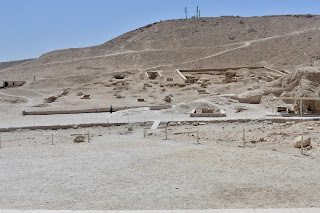





_1_of_4.jpg)




